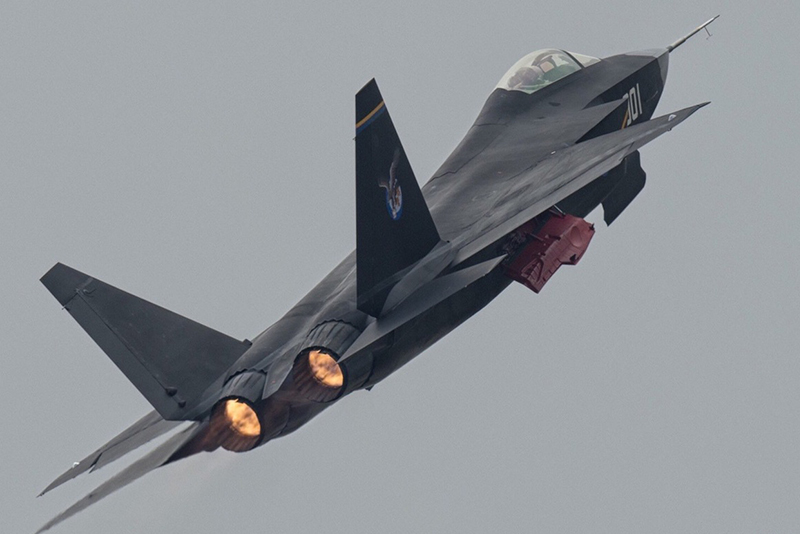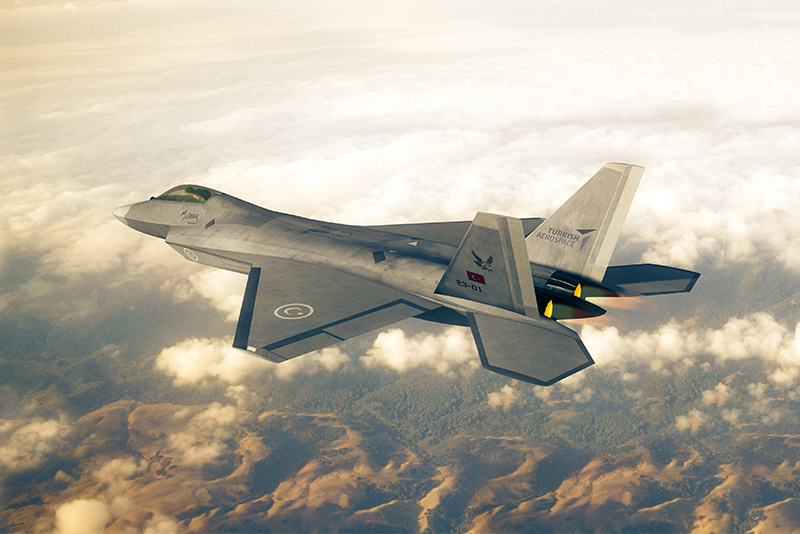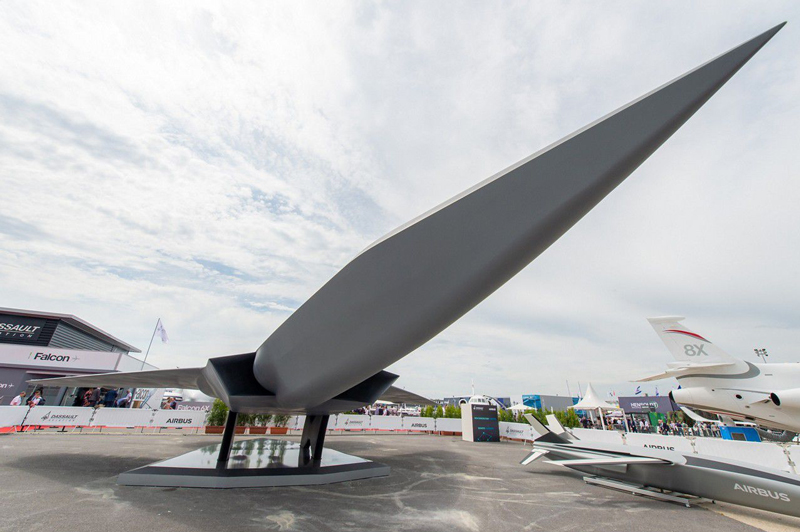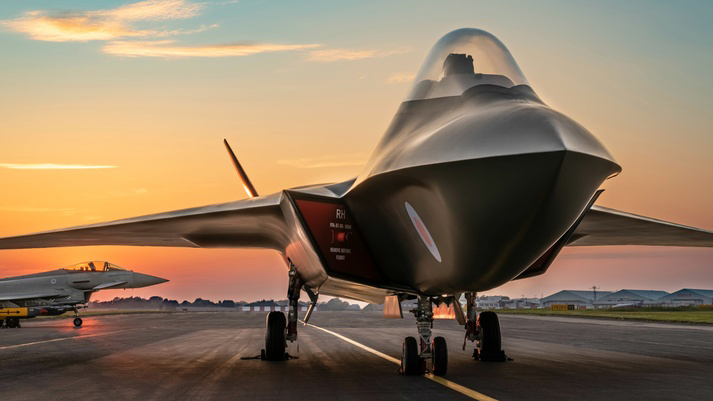
International competition is “hotting” up to design alternatives Lockheed Martin’s 5th Generation F-22 and F-35 combat aircraft. And 6th Generation is just over the horizon.
Predictions about the future of air to air combat aircraft and of tactical fast jet aircraft have changed rapidly. About a decade ago, many expert observers, analysts, and industry insiders confidently predicted that the Lockheed Martin F-35 Lightning II would be the last manned fighter programme, and that manned fighters would give way to advanced and autonomous stealthy drones.
UAV Limitations
But since then, a succession of asymmetric and counter insurgency campaigns have underlined the vital importance of having a human ‘in the loop’, and ‘on the scene.’ Situational awareness is hard to achieve when an operator’s view of the scene is provided by a narrow field-of-view video sensor and via a relatively low-resolution TV screen. There is little ability to detect movement using peripheral vision, nor to pick up a thin wisp of smoke or a momentary glint. A video camera could fail to register visual phenomena like these. Competing demands for bandwidth and enemy GPS jamming can also be limiting factors for unmanned platforms, while latency can make the air-to-air role particularly difficult for an unmanned platform.
As a consequence of these limitations, there has been a distinct shift in attitudes, and Unmanned Combat Air Vehicles (UCAVs) are today seen as a complement to manned combat aircraft, as well as an attributable adjunct. The manned fighter’s future again seems secure, and a number of new types are under development.
Lockheed Martin’s 5th Generation
For some years, it has been assigned that only Low Observable (‘stealthy’) fighters could survive in contested airspace, and that older fighters that lacked radar stealth were, by definition, verging on obsolescence. The 5th Generation label was adopted by Lockheed Martin as a marketing term, aimed at differentiating its new stealthy F-22 and F-35 fighters from their competitors.
Lockheed originally defined the 5th Generation as enjoying all-aspect radar stealth, supermaneouvrability (the capability of fighter aircraft to execute tactical maneouvers that are not possible with purely aerodynamic mechanisms) and super-cruise performance. When it became clear that the F-35’s super-cruise performance was marginal, different characteristics were brought into the definition, including sustained supersonic operations, high altitude capability (>50,000 feet), highly integrated avionics and sensor fusion and net enabled capabilities, but VLO stealth remained the cornerstone of Lockheed’s fifth generation definition.
Others’ 5th Generation
Others defined 5th Generation using different attributes: Boeing would claim the F/A-18E/F Super Hornet was 5th Generation, while Russia’s RSK-MiG (Russian Aircraft Corporation MiG) used the tag for its MiG-35.
There have been some attempts to catch up (or at least narrow the gap) with the F-22 and F-35, and both Russia and China have attempted to develop their own stealth fighters in the shape of the Russian Sukhoi Su-57 ‘Felon’ and China’s Chengdu J-20. But while both of these fighters do incorporate some of the characteristics that are supposed to mark out the 5th Generation, both fail to fully meet Lockheed’s definition.
Russian Sukhoi Su-57
The Su-57 is optimised for reduced frontal RCS, and does feature very high performance and supermanoeuvrability, and has a degree of information fusion though it very clearly does not have all-aspect RCS, and has large, conventional jet pipes.

The Su-57 can engage enemy aircraft at very long range, but is intended to get close to US stealth fighters, forcing them into a WVR engagement, where the Su-57’s supermaneuvrability and 3-D thrust vectoring are intended and expected to give it a decisive advantage.
The Su-57 prototype flew for the first time on 29 January 2010, and series production began in July 2019. Currently 76 Su-57s are scheduled for delivery to the Air Force by 2028, though just 15 have been ordered to date. Plans for the production of 144 aircraft as the FGFA to meet Indian requirements have been abandoned. Su-57s have undertaken brief deployments to Khmeimim air base in Syria for combat evaluation.
China’s Chengdu J-20
China’s first new generation fighter, the Chengdu J-20 is now in frontline service with the 9th Air Brigade at Wuhu Air Base, having made its maiden flight on 11 January 2011.

A large fighter, similar in size to the F-22, the J-20 has a configuration reminiscent of the MiG 1.42/1.44, with a Delta wing, twin tailfins and canard foreplanes. The J-20 does appear to incorporate some LO characteristics, though it appears to be optimised for reduced frontal RCS, and not for all-aspect stealth.
The aircraft is believed to offer a combination of high speed, a large missile load and long range, rather than great agility or very low RCS.
China’s Shenyang J-31
China’s second ‘stealth fighter’ is the Shenyang J-31 (designated FC-31 for export), which is claimed to be cheaper, lighter and more maneouverable than the J-20.
The J-31 bears some resemblance to the original YF-22, though it has conventional circular section convergent/divergent afterburner nozzles, with no thrust vectoring. The aircraft was developed independently as a ‘private venture’ by the state-owned Shenyang Aircraft Corporation, perhaps benefiting from the work of Chinese cyber attackers, who reportedly acquired terabytes of secret information from the database of the Joint Strike Fighter programme.
The prototype first flew on 31 October 2012, but it was not until 2018, that reports emerged suggesting that the FC-31 program has received State funding and was likely to be procured for the People’s Liberation Army Air Force and for the PLANAF.

New Advanced Fighter Programmes
A number of new advanced fighter programmes are now in development. Interestingly, most of these echo the twin-tailed LO configuration of the F-22 and F-35.
Korea’s KAI KF-X
Korea’s KAI KF-X is not a true stealth fighter, and features an external IRST and in its initial form at least, will rely on the external carriage of targeting pods, weapons and fuel, though internal weapons carriage will be introduced after the initial Block I aircraft.
KAI plans to roll out a prototype in the first half of 2021, with a first flight in early 2022, and service entry in 2026.
Turkey’s TF-X
Like the KF-X, Turkey’s TF-X, also known as the National Combat Aircraft (Turkish abbreviation MMU), was unveiled in mock-up form in 2019.
A prototype is due to be rolled out in 2023 with a first flight in 2025, leading to service entry in 2028.
The TF-X is intended to replace the Turkish air force’s fleet of Lockheed Martin F-16C/Ds and was originally expected to augment the F-35, with the TF-X planned to provide better air-to-air combat capabilities than the Joint Strike Fighter, with high manoeuvrability, all-aspect LO, and sensor fusion.

Japan’s F-3
Although Japan has now ordered 105 F-35As (the first 38 being built by Mitsubishi) and 42 F-35Bs, it has an aspiration to maintain indigenous aircraft design and production capabilities and has a requirement for more advanced fighter aircraft.
In February 2019, Japan announced that a new indigenous stealth fighter, the F-3, would be developed as part of the next ten-year Mid-Term Defense Programme (MTDP). This followed speculation that plans for a new indigenous fighter based on the X-2 (previously ATD-X) Shinshin technology demonstrator had been cancelled.
The new fighter will reportedly incorporate a number of technologies tested on the X-2, including EMP-resistant fibre-optic fly-by-light controls, and flight control systems that can automatically compensate for damage, as well as an innovative composite ceramic/silicon carbide skin.
India’s AMCA programme
In India, the Advanced Medium Combat Aircraft (AMCA) programme was launched In October 2008. AMCA is intended to be an indigenous multi-role fighter with high levels of agility, super cruise, heavy payload, and a low radar cross-section. The general configuration was frozen in 2015, and detailed design is now underway. A prototype is now expected to make its first flight in 2032.
These Korean, Turkish and Japanese aircraft could perhaps be described as 5th Generation fighters, but an even more advanced group of combat aircraft is now under development, perhaps inevitably prompting use of the term 6th Generation.
System of Systems and Loyal Wingmen
Each of these programmes aim to produce a manned combat aircraft at the heart of a ‘system of systems’, which will also incorporate unmanned ‘loyal wingmen’ (also known as remote carriers), swarming drones and a host of other connected air power assets.
The future manned fighter may not have a full range of capabilities by itself but will operate as highly-connected network nodes, passing and receiving fused sensor data and other information to multiple other platforms and participants (including ships, ground forces and satellites), contributing to a complex and highly accurate picture of the battlespace. This promises to ensure unmatched situational awareness for the pilot.
The manned fighters at the heart of these programmes are still in the study stage, with different concepts and aircraft configurations still being assessed. Some expect there to be less emphasis on radar stealth but rather a more balanced effort to reduce radar, IR, electronic, acoustic and even visual signature. There may be a greater emphasis on increased speed and range.
Future Combat Air Systems
Europe took an early lead in drawing up plans for these new Future Combat Air Systems. The Airbus consortium first revealed its FCAS proposal in July 2016, designing the aircraft and its supporting assets in response to a joint German-Spanish Next Generation Weapon System (NGWS) requirement.
France and Germany signed a High Level Common Operational Requirements Document for an FCAS (also known as SCAF or Système de Combat Aérien Futur) in April 2018, with Dassault taking design leadership for the Next Generation Fighter (NGF) element of the NGWS.

Spain formally joined the European Future Combat Air System/Système de Combat Aérien Futur (FCAS/SCAF) programme on 14 February 2019.
The British government and the Royal Air Force’s Rapid Capability Office have joined with BAE Systems, Leonardo, MBDA and Rolls Royce to form Team Tempest in 2018. The group was charged with conducting a wide-ranging Future Combat Air System Technology Initiative (FCAS TI), which was to include a host of technology demonstration programmes.

A new, next-generation fighter concept (dubbed Tempest) was unveiled on 16 July 2018 at the Farnborough Airshow, but this represented just one in a range of concepts explored by Team Tempest. It was indicative only of a possible direction of travel – a glimpse into what the future could look like, though it did indicate that the UK was pushing to develop a new manned combat aircraft within its FCAS system or systems.
On 19 July 2019 Sweden and the United Kingdom signed a memorandum of understanding (MoU) to explore ways of jointly developing sixth-generation air combat technologies, while Italy announced its involvement in Team Tempest on 10 September 2019.
The United States Air Force is looking at a similar ‘System of Systems’ approach to meet its – Next Generation Air Dominance (NGAD) requirement. This was intended to include a Next Generation Tactical Aircraft (the so-called Penetrating Counter Air (PCA) aircraft) to replace the Boeing F-15 Eagle and the Lockheed Martin F-22 Raptor in the air superiority and air dominance roles.
The United States Navy is examining its own Next Generation Air Dominance analysis of alternatives, seeking a replacement for the Boeing F/A-18E/F Super Hornet and E/A-18G Growler for service entry in the 2030s. The Navy places less emphasis on Stealth, but instead focused on increased range, since range was perceived to be a significant limitation for the carrier air wing.
Non-Stealthy Fighters
But 5th and 6th Generation fighters are far from being the ‘only game in town.’ 2019 saw a growing recognition that non-stealthy fighters are not somehow fatally flawed and catastrophically vulnerable and that they still have a vital role to play. The USAF long ago abandoned its ambitious plans for an ‘all-Stealthy’ frontline aircraft fleet, developing a doctrine and tactics that saw older, non-stealthy fighters operating in co-ordination with fifth generation assets.
Most of the world’s leading air forces are developing (or have developed) similar concepts of operations that will see them co-ordinating the operational use of F-35s with operations by their older fighter types. These may offer some different sensor capabilities, some useful performance characteristics, and a much larger arsenal of weapons. 4th and 5th Generation fighters can operate synergistically, with each bringing different strengths and advantages to the fight.
There is even a growing realisation that radar stealth may soon not be the best or most effective means of achieving survivability in a contested environment – counter stealth technologies are being developed and are already starting to proliferate, while the greater use of networked sensors (including IRST systems and EO/IR devices) may make it harder for fifth generation aircraft to successfully ‘hide’.
If bistatic radar, or metre-wave radar, or some other technological advance deprives LO aircraft of their ability to delay or reduce the chances of detection, stealth might start to look as anachronistic and irrelevant as some of the clever camouflage schemes and paints that were once used to hide nocturnal bombers from prowling night fighters, or to reduce their conspicuity if illuminated by searchlights.
Some believe that reprogrammable electronic warfare systems can provide ‘digital stealth’, and represent a more effective means of countering evolving threats. Mark Hewer, Leonardo’s Vice President for the Integrated Mission Solutions Business Area, points out that: “You cannot easily modify a stealth platform to counter new high-end threats, because you can’t redesign the skin of your aircraft, or its internal structure, or its configuration. You have got what you have got.”
This means that when new counter-stealth radars are introduced, there will be little that can be done to counter that, or to restore the combat advantage enjoyed by stealth aircraft. By contrast, EW systems can be upgraded and updated, incorporating new hardware and software and are thereby able to evolve to take account of a changing and dynamic threat, in a way that stealth aircraft cannot.
Others believe that a renewed emphasis on defence suppression and electronic attack offers a better way of ensuring survivability in the modern battlespace.
This may have given a renewed ‘window of opportunity’ for further sales of late ‘fourth generation’, non-stealthy fighters, like the Boeing F-15K/SA/SG/QA Advanced Eagle, the Boeing F/A-8E/F Super Hornet, the Dassault Rafale, the Eurofighter Typhoon and the Saab Gripen, which may continue to compete with later fighter types, perhaps particularly in the Asia Pacific region.
Remarkably, even in the second decade of the 21st Century, the USAF is still placing orders for advanced derivatives of the Boeing F-15 Eagle, a decidedly last-generation fighter which first entered service in 1974, while the Lockheed Martin F-16 (which is of similar vintage) is also continuing to find new customers.
by Jon Lake












